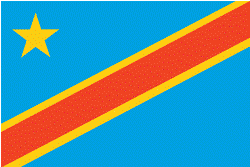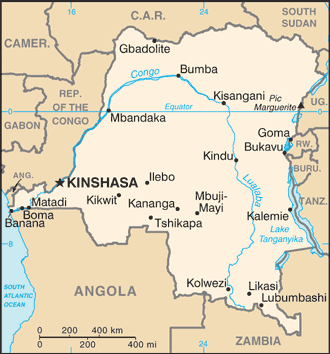Oct 8 2012
Topics Covered
Welcome to Democratic Republic of Congo
Overview of Resources
Metals
Industrial Minerals and Gemstones
Fossil Fuels
Investment
Sources
Welcome to Democratic Republic of Congo
Democratic Republic of Congo (DR Congo) is located to the northeast of Angola in Central Africa. The country was formerly known as Zaire. The total area of the country is 2,344,858 km2, and it has a population of 73,599,190 as of July 2012. The country’s climate is mainly tropical.
 |
The national flag of Democratic Republic of Congo.
Image Credit: CIA Factbook. |
Since gaining independence in 1960, DR Congo has faced political and social disputes interspersed with civil and ethnic wars that involved many of the neighboring countries. The Pretoria Accord was signed to end the fighting and form a national government. In July 2003, a transitional government was finally formed, which formulated a constitutional referendum in December 2005.
All these events have had an adverse effect on DR Congo’s economy causing famine, disease and death, which subsequently led to reduction of government revenue and increase of external debt. Foreign businesses and investment also reduced due to the unsafe environment. The GDP of the country for 2011 was reported as $25.59 billion.
Despite all this, DR Congo is a nation with vast potential wealth with many natural resources such as petroleum, uranium, coal, gold, silver, industrial and gem diamonds, zinc, manganese, tin, tungsten, cobalt, copper, niobium, and tantalum. Its mining sector played a key role in the country’s export income as the prices of minerals recovered after the financial downturn of 2008-2009. Nearly 450,000 artisanal miners have been employed in the mining sector. Aid from the IMF has also helped the economy.
Overview of Resources
DR Congo is the second largest producer of copper in Africa and in 2011 the country exported about half a million t of copper. Recent reports claim that the country has abundant untapped reserves of gold, tin, cobalt and diamonds.
DR Congo’s mineral/metal production statistics for 2010 is as follows:
- Cobalt production was 58% of the world’s total output
- Industrial diamond production was 25%
- Tantalum production was 14%
- Gem-quality diamond production was 5%
- Copper production was 3%
- Tin production was 3%
About 47% of the world’s cobalt reserves can be found in DR Congo. Crude petroleum production also played an important role in the country’s economy in 2010.

The map of Democratic Republic of Congo. Image Credit: CIA Factbook
Metals
In 2010, BHP Billiton Ltd. of Australia was planning on creating a joint venture with the government to build a new aluminum smelter in Bas-Congo Province with a production capacity of 800,000 Mt/yr.
The Tenke Fungurume project was a joint venture of Freeport McMoran, Lundin and Gécamines with each owning 56%, 24%, and 20% interest, respectively. Mining has been underway since 2009 and expansion of the mine is being considered, so that copper production can be increased to about 175,000-220,000 t/yr by 2012 or 2013.
Switzerland’s Katanga Mining Ltd. was involved with copper and cobalt production at the KTO, the KOV and the T17 Mines and the Luilu refinery. The company aims to increase production to 310,000 t/yr of refined copper, 22,000 t/yr of cobalt in cobalt hydroxide, and 8,000 t/yr of cobalt metal by 2015.
Ruashi Mining SPRL (Metorex Ltd. of South Africa) was involved in the production of cobalt and copper from the Ruashi Mine. The production of refined copper and cobalt increased to 29,790 t and 3,580 t, respectively, in 2010 from 21,371 t and 2,198 t in 2009.
A feasibility study to reopen the Kinsenda copper Mine was carried out by Metorex during 2010. The project is likely to cost between $130 million and $150 million.
A joint venture by Anvil and Mawson was formed to develop the Kapulo project, so that 20,000 t/yr of copper could be produced from the new mine within a 7-year life span.
In 2010, many companies were involved in the production of copper blister, especially in the Katanga Province. Some of the companies are listed below:
- Congo Loyal Will Mining sprl of Hong Kong produced about 16,100 t of copper blister
- Congo Dong Fang International Mining sprl of China produced about 13,300 t
- Rubamin SPRL (a subsidiary of Rubamin Ltd. of India) produced about 5,800 t
The gold mined in the Ituri district of Orientale province, Nord-Kivu province, and Sud-Kivu province is mostly performed by artisanal and small-scale miners. However, the gold mining sector of DR Congo faces many conflicts relating to the military and rebels conducting illegal mining activities. As of 2010, Congolese military controlled the Lugushwa and the Mukungwe Mines in Sud-Kivu Province.
In 2010, Banro Corp. of Canada constructed a new mine at Twangiza in Sud-Kivu Province with a life span of 21 years. The gold mine was expected to produce 5,300 kg/yr. The costs for this project was about $377 million.
AngloGold Ashanti and Randgold Resources Ltd. of UK own the Kibali gold project with each obtaining 45% share. The Kibali Mine was expected to start functioning by January 2014 with plans to produce 12,400 kg in 2014, 16,400 kg in 2016, and 17,200 kg in 2018.
Industrial Minerals and Gemstones
Most of DR Congo’s diamonds are procured by artisanal and small-scale miners, who accounted for 16.8 million carats in 2010. Diamond mines can be found mainly in Kasai Oriental, Kasai-Occidental, and Orientale Provinces.
In the same year, Namakwa Diamonds Ltd. of South Africa mined 40,104 carats of diamond at the Kasai Central project, which was more than the previous year with 20,485 carats. Likewise, Pangea Diamondfields plc of UK produced more than 9 million carats from its Longatshimo River and Tshikapa River projects.
DR Congo’s cement production increased from 443,550 t in 2009 to 527,331 t in 2010 due to the increase in demand for Congolese cement.
Fossil Fuels
In 2010, the government of DR Congo made several grants to global oil companies. The details are provided below:
- Block 1 to Caprikat Ltd.
- Block 2 to Foxwhelp Ltd. of the British Virgin Islands
- Block 3 to SacOil Holdings Ltd. of South Africa
- Block 5 to a joint venture comprising Soco International plc of UK, Dominion Petroleum Ltd. of Bermuda, and state-owned Cohydro
Investment
Reflecting on the highest contribution from the mining sector to the country’s growth in 2011, experts state that Congo’s mining sector has great scope for expansion and revenue generation in the coming years. DR Congo can ease its economic worries if it can sabalise its political and legal systems and promote its mining sector.
The Congolese government is working towards this by upgrading its decade-old mining code. However, this has given rise to some unrest among the investors who want to be included in this process. The global mining community is keen to see how the government will handle this issue and make DR Congo a conducive place for secure mining activities.
The reforms of the government have been slow as the government had to conduct military operations to take control of mines in Kinshasa from the Mai-Mai militia and the Forces Démocratiques pour la Libération du Rwanda (FDLR). However, the FDLR and Mai-Mai still control some of the mines and cause disturbances there. Another concern is that the revenue from the mining sector is not solely used to develop the country but to finance military operations due to continued conflicts.
Disclaimer: The Author of this article does not imply any investment recommendation and some content is speculative in nature. The Author is not affiliated in any way with any companies mentioned and all statistical information is publically available.
Sources